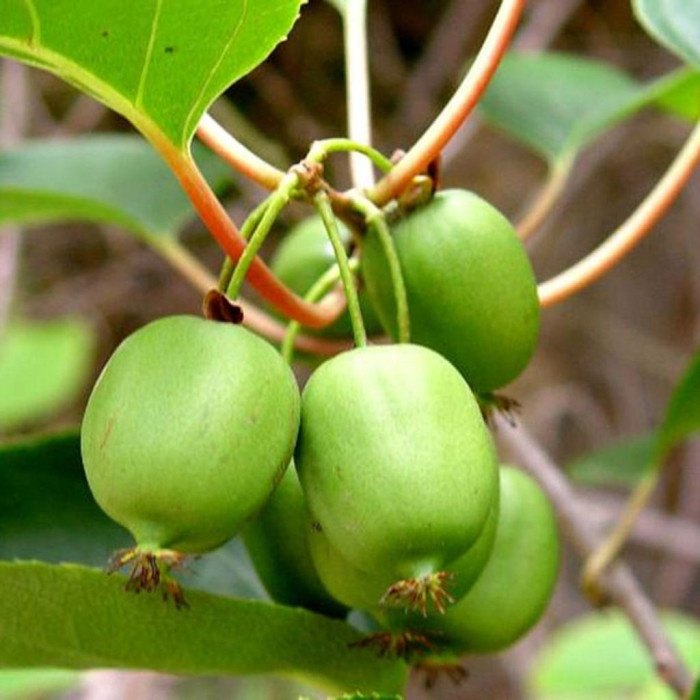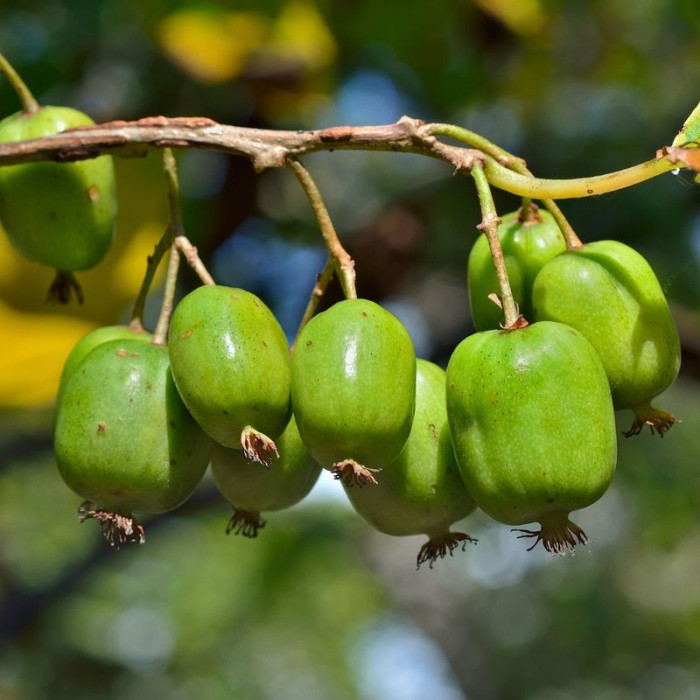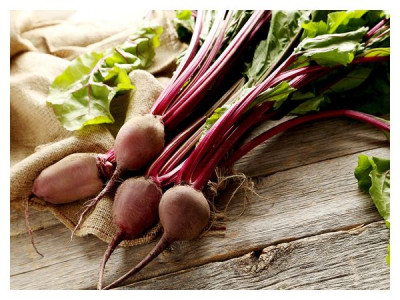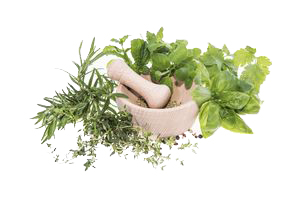Hardy kiwi / Actinidia arguta
Perennial liana, the largest species of the genus Actinidia. The largest liana of the genus, reaches a height of up to 30 m, a trunk diameter of up to 15 cm. The bark is light brown, exfoliating longitudinally. Herbaceous tops of shoots with reddish hairs. The leaves are large, 16 cm long and 13 cm wide, broadly oval, rounded or narrowly oval, entire, with a rounded base, dense, shiny, glabrous, not variegated. Leaf margin finely serrated, sometimes entire. The petiole is dark red, strongly curved.
The flowers are dioecious, fragrant, greenish-white. Male flowers up to 20 mm in diameter, double, collected in an umbrella, anthers black, up to 50 pcs. in a flower. Female flowers up to 16 mm in diameter, in leaf axils, solitary or three flowers. Ovary superior, glabrous, multilocular. Duration of flowering 7-10 days.
The fruit is a berry, 15-30 mm long and 12-27 mm wide, from spherical to cylindrical shape, with a pointed or blunt apex. A ripe berry weighing from 1.5 to 10 g, naked, dark green, with a variety of aromas: pineapple, apple, banana, etc. The skin is thin. The pulp is juicy, tender, sour or sugary-sweet, reminiscent of figs in taste.
Propagated by seeds and vegetatively. Actinidia seeds are sown for seedlings in March - April, planting in open ground in June. Under favorable conditions, it lives up to 100 years or more. In culture since 1874.
The fruits of actinidia contain up to 10% sugars, and glucose is predominant, organic acids are rich in vitamin C - up to 1400 mg /%. Only wild rose can compete with actinidia in terms of accumulation of vitamin C, it is 3-4 times more than that of black currant, 10-13 times more than that of citrus fruits. As the berries ripen, the amount of ascorbic acid in them increases, reaching a maximum in ripe fruits (decreases in overripe ones).
Such a high content of vitamin C allows the use of actinidia as a therapeutic and prophylactic agent for hypovitaminosis and tuberculosis. The average content of P-active substances is low, but even this amount is of great importance for increasing the biological activity of ascorbic acid.
When growing actinidia, it is necessary to take into account its exactingness to the humidity of the air and the surface layer of the soil, where the root system is located. In the non-chernozem zone, moisture is sufficient in ordinary years. In dry weather, watering and mulching of the soil is necessary. The preservation of soil moisture around the vines is one of the conditions for the successful cultivation of these plants in the garden.
It is impossible to dig in plants (trunk circles), since the roots of actinidia are located close to the soil surface. The first part of the fertilizer is applied in March, the second - in May, the third - in August-September. Actinidia can grow well and bear fruit in partial shade. When landing, avoid open sunny places. After planting, the aerial part is shortened to a height of 5 cm, leaving 2-3 well-developed buds on each shoot. Later, shallow loosening, removal of weeds and mulching of the soil are necessary.
During the summer, several times you need to pour fresh earth to the root collar to prevent the roots from being exposed. And of course, watering, if necessary.
Fertilizers for actinidia are best applied for autumn tillage (in October) - 8-10 kg / m2 of manure or compost, 30-50 g / m2 of superphosphate and 15-20 g / m2 of potassium chloride or potassium salt.
Actinidia is best grown on a trellis 2-2.5 m high. To do this, you can use reinforced concrete or wooden poles impregnated at the base with mastic or asbestos-cement and discarded metal pipes with a diameter of 5-8 cm. They are dug into the soil to a depth of 70 cm at a distance of 4- 5 m apart. An aluminum or metal wire with a cross section of 3-5 mm is pulled between the posts in 3 rows (the lower wire is at a height of 50-60 cm from the soil level). Planted plants leave no more than 2 shortened shoots with 2-4 buds on each.
As the shoots grow, one of the strongest is left. It is tied vertically, and the rest are removed. Actinidia is not very susceptible to pests and diseases, so no special plant protection measures are provided.

No questions about this product, be the first and ask your question.









